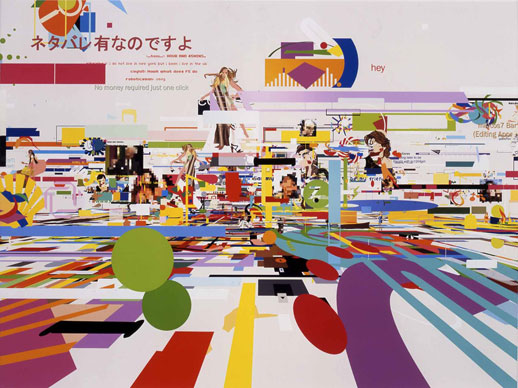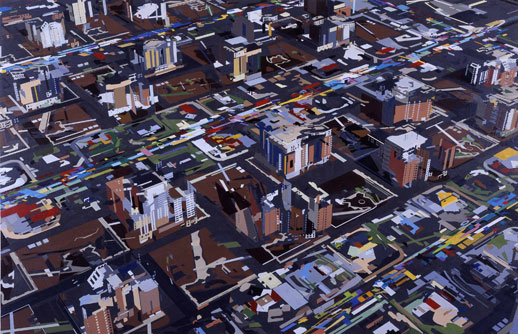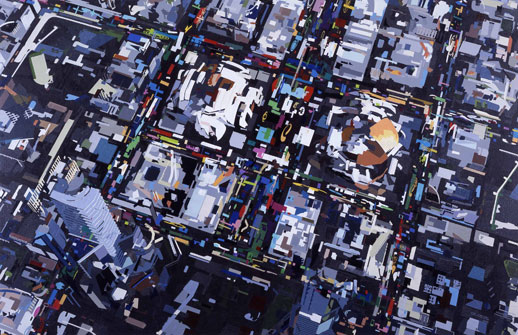Digital Cities: Benjamin Edwards’ Utopian Dreams
The work in this show is divided into two rooms, the smaller of which is dedicated to Edwards’ 2007 ‘Ether Studies’ series of candy-colored inkjet prints on white paper. The pieces at first appear to be nothing more than bright, jumbled collages. On closer inspection, however, the images fall into Renaissance perspective, and the jumble turns out to be a streetscape of sorts, with pixelated people wandering between “buildings” made up of hovering clouds of disparate digital elements: blurry photographs, numbers, symbols, Japanese characters and snippets of Roman text.

The technology of digital printing gives these pieces a purity of color and a crispness of edge that would not be possible in any other medium. Edwards cleverly separates the image from the whiteness of the paper background by using subtle cream-colored ink to color the “sky.” In his world, as in much of Tokyo, architecture is delineated only by colorful signage and the sky serves simply as a pale backdrop to the action below.
Like Edwards’ digital prints, the large-scale paintings in the gallery’s main space appear abstract, forming dark camouflage-like patterns. But again closer attention is repaid as each canvas reveals a detailed cityscape rendered in strips of color that could be boulevards, empty lots, or parks. Multi-scaled grids suggest buildings of varying heights and typologies.

In fact these paintings present multiple views of the same cityscape. All of them were executed as variations upon the theme of another, larger painting that has occupied Edwards’ time for the past year: a monumental work called The Triumph of Democracy. Commissioned for a corporate lobby in Washington D.C., Edwards’ home base, the painting depicts a single view of an imaginary metropolis that he and his studio assistants have painstakingly constructed using computer software.
Understandably, Edwards was eager to explore his digital city in the additional views exhibited here. In an email he wrote, “to create [The Triumph of Democracy] I constructed a virtual city […] and the space had a reality to it beyond the limits of the virtual camera I used for the composition. So I had a real desire to see what this city would look like from different angles. Because of the complexity of the architecture that I create, it’s not possible to see all of these buildings at the same time in the virtual space. The city exists as a hypothetical first, as a grouping of simple blocks, and only after a camera is fixed can the hard work of implementing the scene begin. Each building must be loaded then rendered separately. These images are then pieced together in Photoshop.”

For the pieces in this show, Edwards used a similar technique to construct birds’ eye views of his capital. The resulting images show fragmented high-rises, busy streets and flashing lights set against a textured backdrop of asphalt gray.
Edwards’ one-man show here in Tokyo coincides with the group show “Worlds Away: New Suburban Landscapes” at Minneapolis’ Walker Art Center, where his paintings are on display alongside several architectural projects. It makes sense given the undeniably spatial implications of his work.
“People often ask me if I trained to be an architect because my work is so much about cities and architecture,” Edwards says. “But I really came to it from the ground up, first as an ordinary observer of my suburban and urban surroundings and later through my own research of architectural history. I think that I have architecture in my bones because I’m by nature a utopian and I believe in problem solving. At the same time I can see what a letdown almost all utopian architecture can be. So much of my work is about that disconnect between the hope and aspirations of the plans on the one hand and the almost inevitable failure of those plans on the other.”
Jessica Niles DeHoff
Jessica Niles DeHoff



